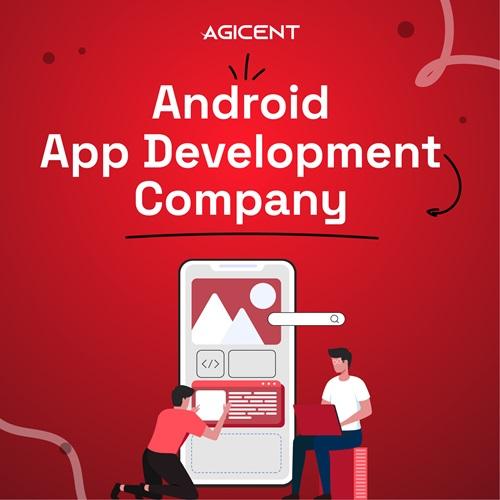Android App Development Company
Android App Development Services from Agicent
Android is touted as the right choice for startups and emerging companies. Our Android development services ensure that it is fully capable of supporting established companies and their SME counterparts. We are an android development company that guarantees scalability with expertise in everything related to what is android app development.
Here are some of our prominent and Recent App releases, with their respective Android App Development Costs
Apple Pie is a fun social media app curated just for teachers! Take the teachers’ lounge to the Apple Pie app. The app offers major social features like following, comments, likes, threaded responses, notifications and advertisement rendering. We created it from the idea to everything now live!
Approx Development Cost: $ 40,000
TELE ASTRO CONSULTING APP - REAL TIME CALLS, BILLINGS, AND EARNINGS!
Jyotish for All or Astro for all is a Tele Astro consulting app just like any telemedicine app where you can talk to any live expert astrologer, tarot card reader, mystique on their per minute charge via video, audio calls or chats. The billing is real time, we implemented wallet which works globally and using Agora to facilitate the video calls, same framework that is being used in famous Clubhouse App. With 10K users in its first month of launch, we are hoping highly for the App.
Approx Development Cost: $ 60,000
Rates for Mobile App Developers on Demand
Following is the standard rate card for different Exp and skill levels of On Demand iOS App Developers. Besides this, we can also create a custom on Demand App Team and optimized the monthly rate based on your specific needs.
1 ) Junior Mobile App Developer
Exp. Level: 1-2 Years
Hands on iOS Development
3 Projects experience minimum
Agicent’s inhouse trained
Familiar with PM Tools
2) Mid-level Mobile App Developer
Exp. Level: 2-5 Years
10 Projects experience minimum
Backend Experience
Hands on CI/CD pipeline
Manages Jr. Developers
Perfect for complex react-native projects and fast Development.
3) Senior Mobile App Developer
Exp. Level: 5+ Years
15 Projects experience minimum
Full Stack Developer
Participate in Architecture
play Tech. Lead Role.
Our work
Agicent Technologies, recognized as a top Android app development company, takes pride in an extensive portfolio of over 1000 mobile apps, web apps, games, and desktop software. Awarded as the Top App Company in 2021 by Mobile App Daily, Agicent collaborates with a diverse clientele, including startups (e.g., HASfit, Wellcure, SmartIRX), established companies (e.g., Anton Paar GmBH, State Restaurant Equipment Inc), and industry giants (e.g., Tata Consultancy Services). Each project reflects Agicent's commitment to delivering superior Android apps and digital products consistently.
App Development Process at Agicent App Company
1. The App Discovery Phase
The discovery phase is the most important foundation phase of any App development Project. Some clients come up with just an idea, some come up with App wireframes, and a few with full specifications (read – how to write app specs yourself?) and we modify the App Discovery Process Accordingly. Simply stating, this is what we do during discovery phase –
Step 1 – We understand your vision around the App idea, then you Business Goal, and the App’s ultimate Goal and USP.
Step 2 – We gather features & functionality that you want in the app, we put our suggestions too and record everything.
Step 3 – We discuss the strategy in terms of if you want to launch an MVP App first or a full product, your preferable launching date, marketing plans etc.
Step 4 – We document all these requirements to put forward for the next step of App analysis, App Estimation, Technology & Architecture Identification.
2. The App Development Proposal
Once discovery phase is over, it is time for us to craft a custom App Development Proposal for you. The proposal is usually these parts –
Executive Summary, App’s Goal, Your Goal.
About Teams.
Cost of Development in phases, timelines, payment frequency.
Delivery Schedule.
App Development Process, communication protocol, Project management cadence.
Once you sign the proposal, we get going within a short lead time of usually 1 week and maximum 2 weeks.
3. Wireframes > Polished High-Fidelity Designs
We believe in user-oriented design led engineering, so whatever we need to offer to the user in terms of the App is to be visualized first – everything else later. Simply put, this is the step where you start visualizing your App in action first through black and white wireframes and then through high fidelity designs (Examples in images). The process is as follows –
App Wireframes Round 1 – Based on the feature list, we create first set of major screens as black and white App wireframes and send to you/ take a walkthrough together for feedback. The idea is to finalize the layout, user flow (UX) on the app.
App Wireframes Round 2 – Last round’s feedback are incorporated, and another round of approval feedback and once finalized we jump on creating high fidelity App designs.
App High Fidelity Designs Round 3 – Once wireframes are finalized, its time to put skin onto them. We pick the wireframes and then convert them into highly user friendly and aesthetically appealing intuitive app designs (see image) and send for your feedback.
4. Coding, Implantation, Testing, Interim Releases
All set and done, we start the heavy lifting here! Our App developers start doing the coding effort on all ends (Front end, Backend, Middle Layer). The project is divided into tasks and sub tasks assigned to the corresponding engineer and the work starts. Generally speaking, following is how the App Development proceeds –
Round 1 of App Development First set of features developed, released to Agicent’s App tester for internal Testing. Once they pass, we release it as an Interim Progressive App to the client of their review/ testing.
Round 2 of App Development – Next set of features developed, released to Agicent’s App tester for internal Testing. Once they pass, we release it as an Interim Progressive App to the client of their review/ testing.
Next Round of App Development – Integration of backend and front end, release dynamic (with real time data) App for internal testing and then to the client for their review.
Final Round (s) of App Development – All front-end Apps completed with full features, integrated fully with the backend, fully tested by our internal team. Then it is released to the client for their final review.
5. Warranty Phase
Generally, we offer FREE 6 months no strings attached warranty for any App Development project we undertake. So we have your back for half an year even after going live for no cost.
Future of Mobile App Development
1) Smart Home Automation/ IoT
There is no doubt that all new Apps are going to be IOTenabled in some way or another. You metaverse Apps will start controlling your home devices and car and many other aspects of life. With the advent of advanced internet enabled devices and appliances, it is become easier everyday to integrate your app with these for greater purposes than just consuming or generating the content.
We believe, mobile apps are going to play a core role in the advancement of Home automation and IOT world.
2) Advance Cross Platform Frameworks
All major cross platform communities are working towards making those as the perfect replacement of native technologies, so much so that they are striving to have single code base for not only different front end platforms but also for the backend. Ready to use libraries for repeat functions are being improved and we can soon see these cross-platform frameworks becoming the new Java of the mobile apps world.
3) Advance No Code Frameworks/ Low Code Frameworks
Not everyone can afford to hire a development team to create their app, and not everyone can learn to code oneself and this aspires innovative engineers to create Low Code/ No Code App Development Frameworks. These frameworks may not be able to create complex Apps using drag and drop kind of things today, but they are in pursuit of reaching at a point where they can blend with the custom code easily and save a lot of App development time and hence cost. They will charge their own fee, but it can be worth it atleast during the MVP phase.
4) High End Apps for Healthcare/ Personal Health
Healthcare is one of the biggest fields that is most receptive to technology advancements and exploited mobile apps for various usage like Telemedicine, EMR/ EHR, Health journaling, Insurance, device integration and more. However, the next wave of Mobile devices advancement may enable users to measure much more data points of their body than just heart rate or BP. New generation of Mobile devices and Apps will not just check on you when you want, but will keep a track of your overall data and life progress and help you avoiding future issues and keep healthy for long.
Source:
https://www.agicent.com/android-development-companyAndroid App Development Company
Android App Development Services from Agicent
Android is touted as the right choice for startups and emerging companies. Our Android development services ensure that it is fully capable of supporting established companies and their SME counterparts. We are an android development company that guarantees scalability with expertise in everything related to what is android app development.
Here are some of our prominent and Recent App releases, with their respective Android App Development Costs
Apple Pie is a fun social media app curated just for teachers! Take the teachers’ lounge to the Apple Pie app. The app offers major social features like following, comments, likes, threaded responses, notifications and advertisement rendering. We created it from the idea to everything now live!
Approx Development Cost: $ 40,000
TELE ASTRO CONSULTING APP - REAL TIME CALLS, BILLINGS, AND EARNINGS!
Jyotish for All or Astro for all is a Tele Astro consulting app just like any telemedicine app where you can talk to any live expert astrologer, tarot card reader, mystique on their per minute charge via video, audio calls or chats. The billing is real time, we implemented wallet which works globally and using Agora to facilitate the video calls, same framework that is being used in famous Clubhouse App. With 10K users in its first month of launch, we are hoping highly for the App.
Approx Development Cost: $ 60,000
Rates for Mobile App Developers on Demand
Following is the standard rate card for different Exp and skill levels of On Demand iOS App Developers. Besides this, we can also create a custom on Demand App Team and optimized the monthly rate based on your specific needs.
1 ) Junior Mobile App Developer
Exp. Level: 1-2 Years
Hands on iOS Development
3 Projects experience minimum
Agicent’s inhouse trained
Familiar with PM Tools
2) Mid-level Mobile App Developer
Exp. Level: 2-5 Years
10 Projects experience minimum
Backend Experience
Hands on CI/CD pipeline
Manages Jr. Developers
Perfect for complex react-native projects and fast Development.
3) Senior Mobile App Developer
Exp. Level: 5+ Years
15 Projects experience minimum
Full Stack Developer
Participate in Architecture
play Tech. Lead Role.
Our work
Agicent Technologies, recognized as a top Android app development company, takes pride in an extensive portfolio of over 1000 mobile apps, web apps, games, and desktop software. Awarded as the Top App Company in 2021 by Mobile App Daily, Agicent collaborates with a diverse clientele, including startups (e.g., HASfit, Wellcure, SmartIRX), established companies (e.g., Anton Paar GmBH, State Restaurant Equipment Inc), and industry giants (e.g., Tata Consultancy Services). Each project reflects Agicent's commitment to delivering superior Android apps and digital products consistently.
App Development Process at Agicent App Company
1. The App Discovery Phase
The discovery phase is the most important foundation phase of any App development Project. Some clients come up with just an idea, some come up with App wireframes, and a few with full specifications (read – how to write app specs yourself?) and we modify the App Discovery Process Accordingly. Simply stating, this is what we do during discovery phase –
Step 1 – We understand your vision around the App idea, then you Business Goal, and the App’s ultimate Goal and USP.
Step 2 – We gather features & functionality that you want in the app, we put our suggestions too and record everything.
Step 3 – We discuss the strategy in terms of if you want to launch an MVP App first or a full product, your preferable launching date, marketing plans etc.
Step 4 – We document all these requirements to put forward for the next step of App analysis, App Estimation, Technology & Architecture Identification.
2. The App Development Proposal
Once discovery phase is over, it is time for us to craft a custom App Development Proposal for you. The proposal is usually these parts –
Executive Summary, App’s Goal, Your Goal.
About Teams.
Cost of Development in phases, timelines, payment frequency.
Delivery Schedule.
App Development Process, communication protocol, Project management cadence.
Once you sign the proposal, we get going within a short lead time of usually 1 week and maximum 2 weeks.
3. Wireframes > Polished High-Fidelity Designs
We believe in user-oriented design led engineering, so whatever we need to offer to the user in terms of the App is to be visualized first – everything else later. Simply put, this is the step where you start visualizing your App in action first through black and white wireframes and then through high fidelity designs (Examples in images). The process is as follows –
App Wireframes Round 1 – Based on the feature list, we create first set of major screens as black and white App wireframes and send to you/ take a walkthrough together for feedback. The idea is to finalize the layout, user flow (UX) on the app.
App Wireframes Round 2 – Last round’s feedback are incorporated, and another round of approval feedback and once finalized we jump on creating high fidelity App designs.
App High Fidelity Designs Round 3 – Once wireframes are finalized, its time to put skin onto them. We pick the wireframes and then convert them into highly user friendly and aesthetically appealing intuitive app designs (see image) and send for your feedback.
4. Coding, Implantation, Testing, Interim Releases
All set and done, we start the heavy lifting here! Our App developers start doing the coding effort on all ends (Front end, Backend, Middle Layer). The project is divided into tasks and sub tasks assigned to the corresponding engineer and the work starts. Generally speaking, following is how the App Development proceeds –
Round 1 of App Development First set of features developed, released to Agicent’s App tester for internal Testing. Once they pass, we release it as an Interim Progressive App to the client of their review/ testing.
Round 2 of App Development – Next set of features developed, released to Agicent’s App tester for internal Testing. Once they pass, we release it as an Interim Progressive App to the client of their review/ testing.
Next Round of App Development – Integration of backend and front end, release dynamic (with real time data) App for internal testing and then to the client for their review.
Final Round (s) of App Development – All front-end Apps completed with full features, integrated fully with the backend, fully tested by our internal team. Then it is released to the client for their final review.
5. Warranty Phase
Generally, we offer FREE 6 months no strings attached warranty for any App Development project we undertake. So we have your back for half an year even after going live for no cost.
Future of Mobile App Development
1) Smart Home Automation/ IoT
There is no doubt that all new Apps are going to be IOTenabled in some way or another. You metaverse Apps will start controlling your home devices and car and many other aspects of life. With the advent of advanced internet enabled devices and appliances, it is become easier everyday to integrate your app with these for greater purposes than just consuming or generating the content.
We believe, mobile apps are going to play a core role in the advancement of Home automation and IOT world.
2) Advance Cross Platform Frameworks
All major cross platform communities are working towards making those as the perfect replacement of native technologies, so much so that they are striving to have single code base for not only different front end platforms but also for the backend. Ready to use libraries for repeat functions are being improved and we can soon see these cross-platform frameworks becoming the new Java of the mobile apps world.
3) Advance No Code Frameworks/ Low Code Frameworks
Not everyone can afford to hire a development team to create their app, and not everyone can learn to code oneself and this aspires innovative engineers to create Low Code/ No Code App Development Frameworks. These frameworks may not be able to create complex Apps using drag and drop kind of things today, but they are in pursuit of reaching at a point where they can blend with the custom code easily and save a lot of App development time and hence cost. They will charge their own fee, but it can be worth it atleast during the MVP phase.
4) High End Apps for Healthcare/ Personal Health
Healthcare is one of the biggest fields that is most receptive to technology advancements and exploited mobile apps for various usage like Telemedicine, EMR/ EHR, Health journaling, Insurance, device integration and more. However, the next wave of Mobile devices advancement may enable users to measure much more data points of their body than just heart rate or BP. New generation of Mobile devices and Apps will not just check on you when you want, but will keep a track of your overall data and life progress and help you avoiding future issues and keep healthy for long.
Source: https://www.agicent.com/android-development-company




